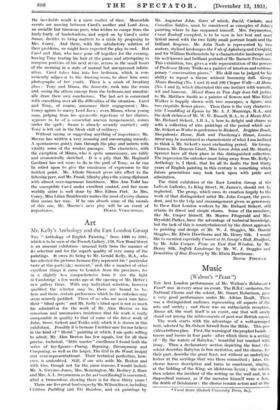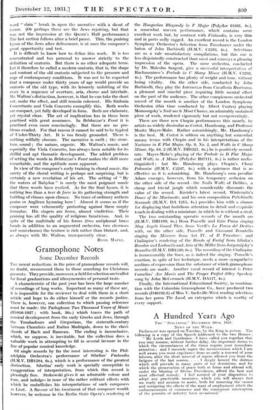Music (Walton's "Feast")
TILE first London performance of Mr. Walton's Belsktc.:ar's Feast* was in every sense an event. The B.B.C. orchestra, the National Chorus and the soloist, Mr. Stuart Robertson, gave a very good performance under Mr. Adrian Boult. There was a distinguished audience representing all aspects of the arts and society ; and there was an enthusiastic reception. Above all, the work itself is an event, one that will surely stand out among the achievements of post-war British music, The work starts with the advantage of a well-arranged text, selected by Mr. Osbert Sitwell from the Bible. This pro- vides a triform plan.. First, the warning of the prophet Isaiah- - tenors and basks in four parts—after which there is a setting of " By the waters of Babylon," beautiful but touched with. irony. Then a declamatory section. depicting the feast : the soloist describes Babylon in free recitative, and the chorus, for their part, describe- the great feast, not without an underlying horror at the sacrilege that was there committed ; later, the chorus leaves description and turns to enactment, singing, at the bidding of the King, an idolatrous hymn ; the soloist then relates the incident of the Writing on the wall and, in a rhapsodical manner, as if the narrator himself were a Jew, the death of Belshsmzar : the chorus remain actors and at the
• * Vocal Score (Oxford:University Press, 38.). word " slain " break in upon the narrative with a shout of terror. (Or perhaps these are the Jews rejoicing, but that was not the impression at the Queen's Hall performance.) The last section follows after a brief pause. This, the praising hymn of the Jews after deliverance, is at once the composer's great opportunity and test.
It is difficult to know how to define this work. It is too concentrated and too personal to answer strictly to the definition of oratorio. But there is no other adequate term. Let it therefore be called a modern oratorio, that is, the shape and content of the old oratorio subjected to the pressure and urge of contemporary conditions. It was not to be expected that a composer under thirty years of age would provide an oratorio of the old type, with its leisurely unfolding of the story in a sequence of overture, aria, chorus and interlude. Mr. Walton's distinction, however, is that he can take the short cut, make the effect, and still remain coherent. His Sinfonia Concertante and Viola Concerto exemplify this. Both works arc compact, yet fully developed in form. Both are elaborate, yet crystal clear. The art of implication has in these been practised with great assurance. In Belshazzar's Feast it is practised even more convincingly. But there are no pro- blems evaded. For that reason it cannot be said to be typical of Under-Thirty Art. It is too firmly grounded. There is nothing wilfully obscure. The narrative is swift ; the struc- ture, sound ; the nature, organic. Mr. Walton's music, and especially the Viola Concerto, has always been notable for its skilful and apt thematic development. The added problem of setting the words in Belshazzar's Feast makes the skill more remarkable, and the aptitude more apparent.
In view of the composer's early training in choral music, the surety of the choral writing is perhaps not surprising, but is certainly a new revelation of his art. The setting of " By the waters of Babylon " is surely the most poignant music that these words have evoked. As for the final hymn, it is nothing less than a tour de force in its gathering strength and building of climax upon climax. No trace of ordinary anthem praise or Anglican hymning here ! Almost it seems as if the composer were vehemently protesting against these empty formulae. His singers are fierce, almost vindictive. Their praising has all the quality of religious fanaticism. And, in spite of the multitude of his forces (two antiphonal brass bands in addition to an augmented orchestra, two choruses and semi-chorus) the texture is rich rather than blatant, and, as always with Mr. Walton, transparently clear.
BAsii. 14IAIti E.











































 Previous page
Previous page